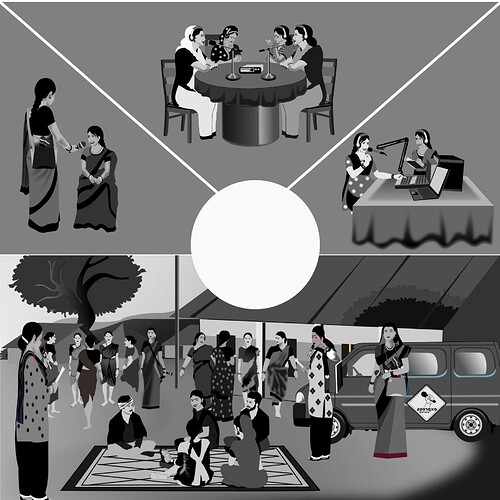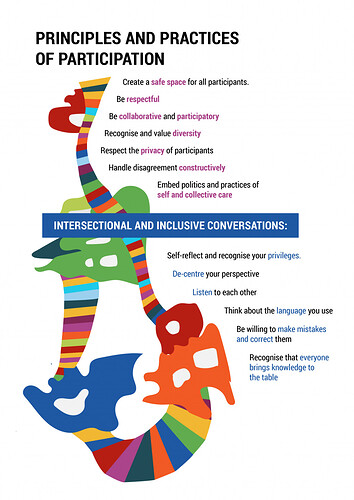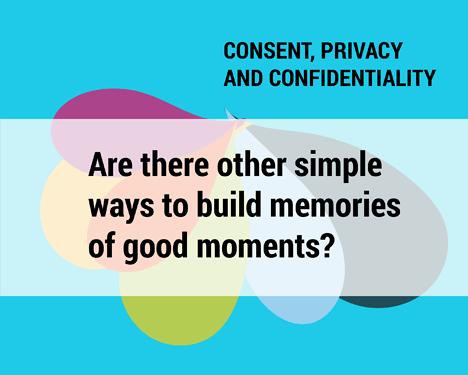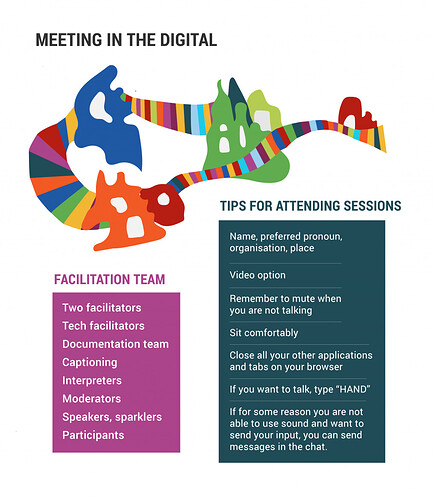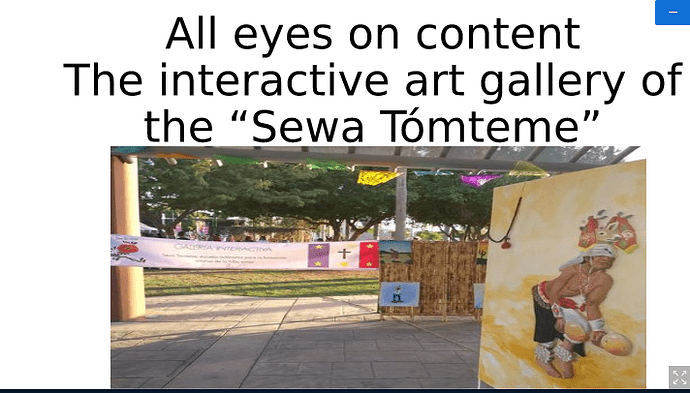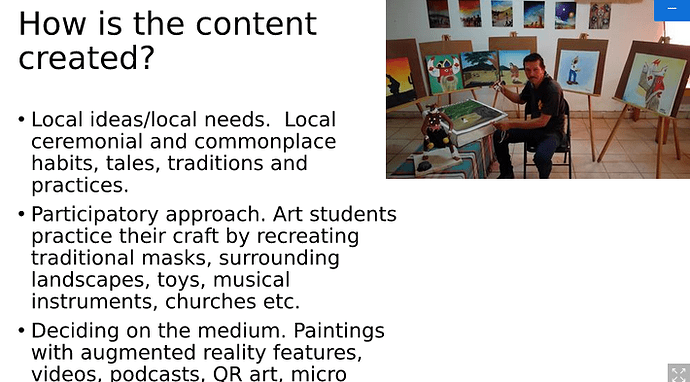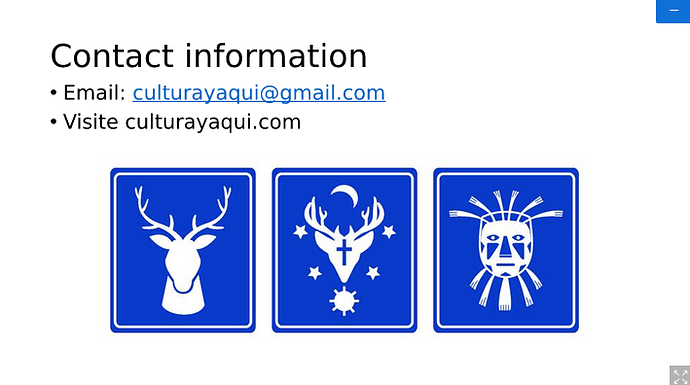Live transcription
Nice to meet you, I am Bruna Zanolli, Co-coordinator with Nils at WP4.
Happy to present this first webinar of the year on content production.
Igor will explain how translation works.
Igor:
Igor from APC, if any tech issue please send a message on the chat.
We will have interpretation in portuguese, english and spanish.
You will see in the bottom of the screen a blue globe icon.

You can change the volume, to see what is best for your hearing.
Bruna:
before we start, Gathering with intention.
A reminder to create a safer space to all participants.
To begin this “All eyes on content” I started my activism with human rights approach with free radio. We not only produced …That is why I deeply believe …
Let’s begin with @Sarbani_Banerjee_Bel , Asia coordination.
she will talk about content on community network: a deeper understanding.
@Sarbani_Banerjee_Bel :
I am Sarbani Belur, Asia regional coordinator of LOCNET Project from APC. Have been working for quite a long time on content creation along with the community. one of the examples you can see is the painting. a painting by the community where all their expression is through painting.
These triangular shapes, everything is triangular.
Happy to present about content in CNs: deeper understanding.
If you look at content in CNs you can see radio content, music, folk…, content that the community can generate on their own.
the next question is what is a relevant content for the community? the community should decide. Community can understand.
…
The question that should be in the back of our mind is that if it is useful for the community. Activity for them…
Multimedia content: we enforce that the content need in a storytelling format, … how the community can avail the content.
Our vs their perspective of content: it should be their perspective on content.
How is the content created: sometimes in the form of music, art, craft, pictures, video, photography. That is how we encourage participation and ownership.
It is a participatory process: the content
has to be made with the community.
Of course, we are doing the type of content production with the community. What are their barriers and challenges? Women inhability to go out after time. They wanted to put that aspect in the content. It is night time, a women walking alone in the street with some men in the street.
It is through the content people self-express.
Local knowledge that you will see

2018/2019 this one was a painting from a community network. saw the telecom power in the community. he wanted connectivity in the school, in the community center, in the locations of agriculture. APC Seed funded project.
During the course of last year, I have developed quite a few content, content with their feedback, animations done by us with communities feedback.
This is one of the content. … They wanted the old women to go to the community support center. the last one was on the community radio. ilustrations done for and by? the community.
This is a depiction of who makes the content.
@bruna :
Thanks Sarbani, I nice circle, I appretiate the drawing . Let’s go now with Cocó Ramirez, are you here? Igor will play the slides whenever you are ready.
Good morning I am Linda and Francisco Ramirez from Northern Mexico. We are from an Arts School that is called … which means blossom, we want to make peoples minds blossom with different works: puppets, books, interactive art.
Cocó Ramirez has created the concept for the gallery. What we are trying to do is to promote the use of technology in a more creative way. Many young people ha
ve cellphone they can be used in more creative ways then just Facebook.
The content is created by the students, they paint traditional dancers and landscapes. The inspiration comes from the community and they promote it amongst themselves. We promote a network between the 18 communities to make them stronger. There is a colonizing aspect of outside culture. So we want to recover self-identity that is implied.
The misuse of the Internet and the excessive consumption of pop culture creates an identity crisis amongst the tribe members, they are part of an ancestral tradition but rather dress up as anime characters and sing songs in japanese…we try to fight this.
And this is where the technology comes in. Teacher Ramirez has developed a simple method of augmented reality. And this has captured the attention of the youngest students. We also have interactive sculptures, you touch them and they start singing…like the doll where you touch the belly and they start singing. We also have interactive books, and the kids paint them, nothing fancy but then you put your cellphone oer them and they start to tell stories…so we mix traditional art with new ones. We also have an eFM radio station, that has been successful with the elderly, the stick to the old way of turning on the radio. People with 60/70 have no interest in the Internet but they turn on the radio. Very useful for personal announcements and all the contents come together in the use of the community or are created just be them.
Cocó quieres añadir algo? In our school, que creamos 3 años atras trabajamos en la galeria interactiva pero es itinerante tambien, la podemos llevar por diferentes lugares. Podemos crear micro-redes con informacion realtiva al pueblo Jaqui, visto bueno por las autoriudades. Es un trabajo participativo, es un tema constante, lo llamamos technologia de vinculación.
Bruna:
Muchas gracias. It is so hard… the problem of assess and how to make it not missused, people less engaged … how combined …
We will hear about Girish.
Girish:
Namaste all. My name is Girish. I was working on mass video and now switched to micro media.
In mass media there is lots of information, good/bad,… had an example from my home town.
My father doesn’t want to be inside the house. mother/parents don’t want to use mobile phones. …
Industry of mass media whatever content is done there is a team doing content. Director, anchor, editor… a set of people. They will have an idea, they will script… they imagine a content and then make content.
Now people want to learn anything over youtube. … content making we have to cook something to develop the channels… ratings… criteria of mass media.
Micro media, a very simple gadget. two people are sitting right there. The woman is trying to record everything. The difference is that they want to share their real stories. Platform were minimum gadgets. They have a raspberry-pi, a microphone and a small receiver that looks like a radio. This is off-grid. this kind of possibilities are needed for them to express. It is very difficult for them to express on mass media.
Micro media creators are community leaders, members and represntatives. They talk about the needs of the community, the problems they have. members share their experiences of lifestyle, practices (food, culture, livelihood). I feel that these things are essential to preserve. Next generation we will all digitize. Difficult to … The man in between was sharing about rituals. they don’t need to type or write, they can just use their voice… when she goes there, … different people themselves built the device used for recording.
Audios of the people now she is recording the stories. we were there trough covid. they recorded stories about that…
Information about the livelyhood (30/35%). To get familiarized to make content. 50% health/covid related recordings. The needs. Concense in the community, needs of the community. Right information given to the authority from the community. Medical officer for this community.
A few instancens were we were setting a community network, landslades very common. in realtime there was a road cut, landslide. People get panic, not able to communicate. A lot of stories there. We had this opportunity: we set up a wifi based radio across the road cut. What happened, how… what we call real time conversations were recorded… a small discussion… we were able to be relaxed and engaged with the radio while they were rebuilding the road. … “When the road will be finished?” it was very difficult to handle the situation.
There was a timely rescue of a child. We wanted to fly. The pilot was… “we have an emergency, we want to go”. difficult to handle. Once we started to do recordings. … instructed to go and pick the child…
As of june 2020 56% digital dark areas in Uttarkhand. Hundreds of these digital dark areas have started connecting to the world through internet.
…
If they connect among themselves, people can go and connect …
Challenges were … sustainability of content creation, and sustainability of the people. as content creation is a soft skill… We have to be … challenge amongst themselves … we have to set a computational train amongst themselves… left out to do content. How do we sustain these people? mitigate this channel, we set a cafeteria with different kind of dishes. The idea was to make sure people can go to the cafeteria and share their ideas … Content creation was so easy, the income was through the cafeteria.
Lack of men participation. Thank you
do check out http://namdu1radio.com
Bruna: Thanks a lot Girish, it was beautiful to see people sitting in the outsid and sharing expreinces, it is very different form traditional mainstream media. I would like to welcome pur next guset Walter from Brazil
Bom dia, eu sou Walter, indigena da regiao de Santarem, Brazil. Fazo rdio que leva conteudo pelo denro da comunidade, para adolecentes e prevencao. Tem um video que vamos tentar mostrar. Nesse video vamos falar como está a vida na Amazonia. A comunicacao nao chega pra todo muno, nao todo mundo e conectado na floresta. Fazemos o trabalho de levar informacao as comunidades, de prevenir, levamos material (cornetas), o proprio material que a joventude está fazendo, faezmos um concurso para enviar materiais e nos multiplicamos o alcance do material, parodias, poesias, etc. Resolvemos levar com o barco essas informacoes. Entao essa imagem traz um pouco isso, quano a gente esta entregando kits de higene e proteccao.
vídeo 1: RádioBarco - YouTube
vídeo 2: RádioAMeFM - YouTube
Aqui a gente tem, na verdade eu em frent com o microfine, ja dentro do estudio da radio. Temos duas radios locais, sao radio AM e FM onde a gente consegue criar conteudo, Halo comunidade e mais um programa, as pessoas mandam conteudo, ja é um pouoc mais pensado como programa (as questoes da música), é um programa que sa faz uma vez por semana, mas pensamos em todo o que colocamos o ar. Fazemos uma divulgacao, temos jovens reporteres, temos jovens que gostam cantar, que compoem as suas proprias musicas, todo o que passa pelo territorio é compartilhado, a Rede Mocoronga se cria para as jovens indigenas podem falar, conseguir levar mensagens, mostrar que dentro da selva tem gente, que previsam educacao é saude.
vídeo 3: Pod´Da-lhe - YouTube
É aqui vemos outra ferramenta que é um Podcast, participam jovens da regiao, indigenas, quilombolas, ribeirinhos…temas mas pessados, sobre agroindustria, etc. Falamos sobre o territorio, mas nao todo mundo consegue ouvir no celular e nao se pode baixar dentro do territorio, as redes nao dao para enviar mensagens. Mas temos estrategias de lancar o Podcast de outras formas: uma caixa de som bluetooth. Este podcast foi lancado agora mas precisamos distribuir mas, na regiao do Nordeste, a oventude estava frente das campanas durante a pandemia, o podcast durge para divulgar informacoa. As radios comunitarias FM também retransmitem o podcast dentro das comunidades, quando a gente lanca o podcast nesse territorio chegamos a 20.000 habitantes na regiao e outrs regioes tambem. Agradesco de poder falar um pouco acerca nossa realidade.
Bruna: thanks
we’ve been talking about this, speaking from the experience.
Now we will invite Gustaff from Common Room.
Gustaff:
Would like to thank for the opportunity.
I would agree with everything shared by Sarbani, Coco, girish and …
Where local content can lead you in the context of indigenous rights.
Context, why local context/knowledge is more and more important.
Human population grew, increased gap in between rural and urban development, covid.
In the context of climate change mitigations, even though indigenous communities are very small in the global context, most of these image are common these days. 80% biodiversity is in 11% areas. West java indigenous focus.
This is the Kasepuhan indigenous community. The location is deep forest. Two extensive collections of local content. We can get to know the history and narrative, with their culture/tradition/everthing.
Customary institutions too, how they run their society.
We can also learn how they manage the forest. The forest is under their jurisdiction, one of the more intact. not only the most populated area but also fastest growing area, very vulnerable.
Able to make a map with the collection of the oral culture and traditions. We can know were are the forests, …
We learned why the sacred forests are protected. We knew that it is were water and nutrition is coming through satelite images.
We also learned a specific way of managing water resources.
We learned also about the farming calendar: their own indigenous farming calendar.
We see corelations between farming practice and traditional astronomy.
How they manage and run the traditional calendar with specific guidelines.
How these traditional farming practices with the data collected we see in 2015 there is a peak of rice production. We had impact of “El niño” at that time. In this region there is an increase during the peak of el niño, a hard fact that their practices tackle climate change.
We collect information in video/photo/drawing… there are many forms of …
How they produce and cultivate their own seeds, no GMOs.
The importance of local content is not only to disseminate local information, but as a tool to advocate and protect these rights.
Bruna:
Thanks so much Gustaff, such a neat presentation and photos. It is amazing to see how to mix ur… using local media can be a great ally to not have the expropriation of local knowledge that happens with communities.
Thanks all of you for your presentations, such a great material!
also want to thank our translators, and also to see that we have created this platform for community networks to share experiences.
@hiure : Si tuviera tiempo me gustaría escuchar a coco sobre el concepto de tecnología de vinculación social
Coco: alrededor de hace 10 años comenzamos a ver la problemática de no poder , de que los pueblos originarios y la tribu Yaqui habia dificultades con el internet. Platicando con las autoridades y gobernadores del pueblo Yaqui buscamos alternativas para que la lengua no fuera desplazada por la presencia tecnológica. Habia posibilidad de hacer navegadores con lengua Yaqui con firefox, que luego fue abandonado. Tambien pensabamos generar como microredes (ahora le llaman intranets). hablamos de un yaquipedia asi como una wikipedia. donde los muchachos pudieran descubrir la lengua yaqui. el concepto de tecnología de vinculacion social que tuviera como proposito integrar al grupo en participación, todos con todos, sino no sirve, no funciona… que esté inmovil no tiene sentido. pensar en todo lo que llega en la integracion de la cultura yaqui.
@batata : tambien para coco acerca de la criacion de contenido con el celular, como?
Los libros se hacen artesanalmente. utilizamos aplicaciones gratuitas o de bajo costo. El tema importante es que cuando se coloca el dispositivo surge un sonido o cancion en yaqui, de manera que el niño está leyendo en su lengua. Está haciendo un aprendizaje significativo. Esa es la idea que tenemos con la galería, recreamos imágenes bajo esa idea también. Podemos tener un pequeño formato impreso, asi como una gran escultura. Pueden ver en culturayaqui.com y en https://www.culturaportatil.com/
todos participan para poder hacerlo, niños y jóvenes. Combinamos tecnología y tradición.
Bruna:
… try to preserve and make these community spaces.
Just to say this wasthe first webinar of the year, we will have another one more focused on the technologies of content production. I really believe that radio production and broadcasting is still an mazing way to express our cultures. Although radio broadcasting is not a trend or hip it is still important and very relevant, we should fight for it, also to embrace tecnologies?
Hawi_Kijiji Yeetu: How do you deal misinformation and disinformation from the content?
Anyone wants to answer this one?
Gustaff: misinformation and fake news is one of the biggest challenges in many parts of the world, not only Indonesia. THe increase of misinformation in social media is extremely incresing. We work together in multi-stakeholder groups to trakc down misinformation, especially Covid19 response, active involvement of civil soiety, scientist and government is curcial, in the context of Covid the consquences can be more dangerous then the virus itseslf.
Bruna. jes we also have big problems, also with political manipulation and gender violence, it is a huge topic.
Wrapping up, I feel really happy, leaving this space with more questions then answers, a goof way to start the year. Are there more questions or would you like to open the cameras.
Walter: em relacao ao faeknew a gente enfrenta muito aqui em nossa regiao, na floresta, a questao do Covid19, tem pouco accesso a informacao. E os fake news circulam masi rapido, isso é preocupante, muitos pensam que por ser indigenas nao sabemos usar celular, mas usam, fazemos filmes, etc. usamos as technologias para denuncair o agronegocio, para combater os preconeptos sobre o territorio, usando o celular de boa manera vao trazer boas coisas para o territorio.
Bruna: just to say, we have one minute left, not sure if we have one more person to speak. Girish, please go ahead…this is not happening. Thanks to all of you for participation and see you all in the next webinar.
